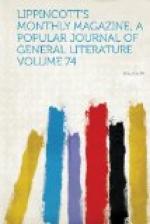The village square is a kind of permanent fair-ground filled with diminutive booths, each one composed of four posts stuck in the ground and upholding a bit of cloth not much larger than a hand-kerchief, under which the hucksters, women and children, sit as under a tent. There is a multitude of sellers, and a pitiful lack of goods to be sold. One woman, with her four children seated near her, offers six eggs to the passer-by as her little store of merchandise: another booth is presided over by two women and three children, and a dozen ears of corn constitute their stock. There is a sad suggestion of poverty about all this which is very depressing. The day before the arrival of M. Forgues in the place an enterprising baker, the first who had ever set foot in Paraguari, began the making and selling of wheat bread. Everybody deserted his customary manioc and bought a loaf of the good fellow, who rubbed his hands with delight at the success of his speculation. The next day, not satisfied with a legitimate profit, he raised the price of his loaves. Human nature is the same all over the world, and the speculator found his bread left on his hands. Nobody would pay his price, and everybody returned to manioc.
From Paraguari our traveler’s course next led him toward Villa Rica, a thriving town situated still farther in the interior, and near the Cordillera of Caaguazu. He sets out accompanied by his Swiss acquaintance. The journey is made in two days and on horseback. Their route in the beginning lies across a small mountain-range, and then through a piece of thick woods bearing an evil reputation as the home of footpads. But the two pass through in safety, for the robbers are either asleep or absent from their haunts. Reaching the head-waters of the Yuqueri, which empties into the Canabe, a tributary of the Paraguay, they skirt the heights of Angostura, where Lopez, after the evacuation of Humaita, planted his batteries, and which he made his final strategic point. Near by, on the right bank of the Canabe, is the field of Las Lomas Valentinas, where the Paraguayan president fought his last great battle. So far, the route had been through an almost unpeopled solitude. In the evening they reach Ibitimi, a village built, as are all the Paraguayan hamlets, in the shape of a square, with its little church in the centre. Here the ravages of war are painfully apparent. Many of the houses have gone to ruin, dismantled piecemeal by passers-by, their owners never having come back from the battlefield to reoccupy them. The surrounding country is charming, and, seated on one side, M. Forgues sketches a cart drawn by oxen which goes by slowly with the declining sun shining on its leather top. An eight-year-old boy of the village, whose attire is limited strictly to a necklace of black seeds, approaches him, looks over his shoulder, and reads aloud the word which he writes under his sketch: “Ibitimi.” Returning from his little sketching excursion to where his companion is awaiting




